The Role of Electricity Balancing and Storage: Developing Input Parameters for the European Calculator for Concept Modeling
Abstract
1. Introduction
1.1. Challenges in the European Electricity Systems
1.2. The Trends and Evolution of Electricity Balancing
Electricity Supply Side
1.3. Changes in the Spread of Photovoltaic and Wind Energy Technologies in the European Union and the Importance of Energy Storage Systems
1.4. The Current Situation of Electricity Storage Technologies
1.5. Various Scenarios for Electricity Storage in 2050
1.6. Introduction of the European Calculator Model
- (1)
- it defines calculation sequences based on material, energy and emissions drivers,
- (2)
- and, then it sets a range of ambition levels on the drivers that are the most important and where the user can define projected levels [44].
1.7. Balancing and Storage in the Context of the European Calculator Concept
2. Material and Methods
2.1. EUCalc Modeling Approach
2.2. Overview of the EU Calculator’s Electricity Module
2.3. The Calculation Logic and the Scope of the Storage Module
- The module calculates the annual electricity supply-demand gap on the trading zone level, considering the EU net electricity import and the balancing possibilities of electricity trade within EU. The annual deficit/excess is handled by capacity changes of fossil fuel power and power-to-X (PtX) generation.
- The module predicts renewable power generation from variable sources (PV and wind), for each country at an hourly level.
- The module breaks down the annual demand of each country into load curves with hourly granularity for each country.
- The module includes trade flows of electricity between groups of countries with high level interconnections (trading zones), thus correcting the supply-demand match with trade, resulting in trading zone level residual load curves.
- The module calculates flexibility needs on three timescales (weekly, daily, and sub-daily), based on the trade zone level residual load curves
- The module integrates specific storage technologies into the calculation to match flexibility needs on three timescales of balancing.
- The module calculates the capacity, yearly production and direct CO2 emission of the additional, flexible power generation that are needed to balance electricity demand with supply at the country level.
2.4. The Link between Balancing and Storage in the EUCalc Modeling Concept
2.5. Determining the Energy Storage Capacity and the Maximum Energy Storage Potential during One Year of Stationary Storage Technologies
- electro-chemical, battery, stationary, 6 h;
- electro-mechanical, compressed air, 12 h;
- electro-mechanical, flywheel, 0.5 h;
- power-to-gas-to-power, 48 h.
2.6. Electricity Trade within the EU
2.7. Variable Renewable Energy Integration Challenges
3. Results and Discussion
3.1. The Logic of the Calculation of the Storage Module
- Step 0: the module matches annual electricity demand with supply, and in case of excess in a trading zone accounts for electricity trade.
- Step 1: the module determines hourly load curves for electricity demand based on load profiles and inputs from electricity consuming sectors.
- Step 2: the module creates the hourly granularity residual supply curves based on hourly capacity factors for PV, on- and off-shore wind power.
- Step 3: the module calculates the residual load curve from the hourly granularity values and generates flexibility needs on three different timescales.
- Step 4: the module assigns different technologies to the different flexibility needs. Disaggregating parameters to country level and adjusting flows between modules:
- Step 5: the module calculates disaggregates the physical storage and generation capacities to individual countries.
- Step 6: the calculation may adjust the primary electricity production due to the adjustment of capacity factors at the hourly level, this module will finalize the values of the flows from the supply module and forward the final data to the Transition Pathway Explorer—these changes are associated with the changes in the capacity factor values influencing not only the produced electricity but the necessary power capacity investments, the used fuel input and produced emissions.
- Step 7: the module determines the cost of electricity production.
3.2. The Development of Cross-Border Capacities within the EU
3.3. Storage Technology Ambition Levels
3.4. European Union Plus Switzerland Variable Renewable Energy Integration Limit
3.5. Summary and the Importance of Input Data Quality
4. Conclusions
Author Contributions
Acknowledgments
Conflicts of Interest
Abbreviations
| CAES | Compressed air energy storage |
| CAPEX | Capital expenditure |
| CEG | Centralized energy generation |
| CF | Capacity factor |
| CH | Switzerland |
| COE | Cost of electricity |
| DEG | Decentralized energy generation |
| DESSTinEE | Demand for Energy Services, Supply, and Transmission in Europe |
| DOE | Global Energy Storage Database |
| DSM | Demand-side measures |
| Entso-E | The European Network of Transmission System Operators for Electricity |
| EU | European Union |
| EUCalc | European Calculator |
| EV | Electric vehicle |
| GHG | Greenhouse gas |
| GTAP | Global Trade Analysis Project |
| JRC IDEES | Integrated Database of the European Energy Sector |
| NREL | National Renewable Energy Laboratory |
| OPEX | Operating expenses |
| PHS | Pumped hydroelectric storage |
| PV | Photovoltaic |
| PtX | Power-to-X |
| TSO | Transmission system operator |
| VRE | Variable renewable energy |
| WACC | weighted average cost of capital |
References
- Gurung, A.B.; Borsdorf, A.; Füreder, L.; Kienast, F.; Matt, P.; Scheidegger, C.; Schmocker, L.; Zappa, M.; Volkart, K. Rethinking Pumped Storage Hydropower in the European Alps. Mt. Res. Dev. 2016, 36, 222–232. [Google Scholar] [CrossRef]
- Coburn, A.; Walsh, E.; Solan, P.J.; McDonnell, K.P. Combining Wind and Pumped Hydro Energy Storage for Renewable Energy Generation in Ireland. J. Wind Energy 2014, 2014, 1–6. [Google Scholar] [CrossRef][Green Version]
- Bertsch, J.; Growitsch, C.; Lorenczik, S.; Nagl, S. Flexibility in Europe’s power sector—An additional requirement or an automatic complement? Energy Econ. 2016, 53, 118–131. [Google Scholar] [CrossRef]
- Blanco, H.; Faaij, A. A review at the role of storage in energy systems with a focus on Power to Gas and long-term storage. Renew. Sustain. Energy Rev. 2018, 81, 1049–1086. [Google Scholar] [CrossRef]
- Kondziella, H.; Bruckner, T. Flexibility requirements of renewable energy based electricity systems—A review of research results and methodologies. Renew. Sustain. Energy Rev. 2016, 53, 10–22. [Google Scholar] [CrossRef]
- Liu, W.H.; Alwi, S.R.W.; Hashim, H.; Muis, Z.A.; Klemeš, J.J.; Rozali, N.E.M.; Lim, J.S.; Ho, W.S. Optimal Design and Sizing of Integrated Centralized and Decentralized Energy Systems. Energy Procedia 2017, 105, 3733–3740. [Google Scholar] [CrossRef]
- Kursun, B.; Bakshi, B.R.; Mahata, M.; Martin, J.F. Life cycle and emergy based design of energy systems in developing countries: Centralized and localized options. Ecol. Modell. 2015, 305, 40–53. [Google Scholar] [CrossRef]
- Ogunjuyigbe, A.S.O.; Ayodele, T.R.; Akinola, O.O. Impact of distributed generators on the power loss and voltage profile of sub-transmission network. J. Electr. Syst. Inf. Technol. 2016, 3, 94–107. [Google Scholar] [CrossRef]
- Agora Energiewende and Sandbag. The European Power Sector in 2017. State of Affairs and Review of Current Developments; Agora Energiewende and Sandbag: London, UK; Berlin, Germany, 2018. [Google Scholar]
- Farfan, J.; Breyer, C. Aging of European power plant infrastructure as an opportunity to evolve towards sustainability. Int. J. Hydrogen Energy 2017, 42, 18081–18091. [Google Scholar] [CrossRef]
- Mac Kinnon, M.A.; Brouwer, J.; Samuelsen, S. The role of natural gas and its infrastructure in mitigating greenhouse gas emissions, improving regional air quality, and renewable resource integration. Prog. Energy Combust. Sci. 2018, 64, 62–92. [Google Scholar] [CrossRef]
- Renewable Energy Policy Network for the 21st Century Renewables 2019 Global Status Report-REN21; REN21: Paris, France, 2019.
- SolarPower Europe. Global Market Outlook for Solar Power; SolarPower Europe: Brussels, Belgium, 2019. [Google Scholar]
- European Wind Energy Association-EWEA. Wind in Power 2015 European Statistics; European Wind Energy Association-EWEA: Brussels, Belgium, 2016. [Google Scholar]
- WindEurope asbl/vzw. Wind in Power 2017-Annual Combined Onshore and Offshore Wind Energy Statistics; WindEurope asbl/vzw: Brussels, Belgium, 2017. [Google Scholar]
- Zappa, W.; Junginger, M.; van den Broek, M. Is a 100% renewable European power system feasible by 2050? Appl. Energy 2019, 233, 1027–1050. [Google Scholar] [CrossRef]
- European Commission. EU Reference Scenario 2016; European Commission: Brussels, Belgium, 2016.
- Hübler, M.; Löschel, A. The EU Decarbonisation Roadmap 2050—What way to walk? Energy Policy 2013, 55, 190–207. [Google Scholar] [CrossRef]
- TaiyangNews. Bloomberg Expects 1400 GW PV for Europe by 2050. Available online: http://taiyangnews.info/markets/bloomberg-expects-1400-gw-pv-for-europe-by-2050/ (accessed on 3 January 2020).
- ENTSO-E. Europe Power System 2040: Completing the Map and Assessing the Cost of Non-Grid. Available online: https://tyndp.entsoe.eu/tyndp2018/power-system-2040/ (accessed on 12 April 2019).
- Delucchi, M.A.; Jacobson, M.Z. Providing all global energy with wind, water, and solar power, Part II: Reliability, system and transmission costs, and policies. Energy Policy 2011, 39, 1170–1190. [Google Scholar] [CrossRef]
- Czisch, G. Szenarien zur Zukünftigen Stromversorgung, Kostenoptimierte Variationen zur Versorgung Europas und Seiner Nachbarn Mit Strom Aus Erneuerbaren Energien. Ph.D. Thesis, Universitat Kassel, Kassel, Germany, 2005. [Google Scholar]
- ENTSO-E. TYNDP 2018-Scenario Report. Available online: https://tyndp.entsoe.eu/tyndp2018/scenario-report/ (accessed on 12 April 2019).
- Zsiborács, H.; Baranyai, N.H.; Vincze, A.; Zentkó, L.; Birkner, Z.; Máté, K.; Pintér, G. Intermittent Renewable Energy Sources: The Role of Energy Storage in the European Power System of 2040. Electronics 2019, 8, 729. [Google Scholar] [CrossRef]
- Czisch, G.; Giebel, G. Realisable scenarios for a future electricity supply based 100% on renewable energies. In Proceedings of the Risø International Energy Conference 2007: Energy Solutions for Sustainable Development, Roskilde, Denmark, 22–24 May 2007; Risø National Laboratory: Roskilde, Denmark, 2007. ISBN 9788755036031. [Google Scholar]
- Kempton, W.; Pimenta, F.M.; Veron, D.E.; Colle, B.A. Electric power from offshore wind via synoptic-scale interconnection. Proc. Natl. Acad. Sci. USA 2010, 107, 7240–7245. [Google Scholar] [CrossRef] [PubMed]
- Schaber, K.; Steinke, F.; Hamacher, T. Transmission grid extensions for the integration of variable renewable energies in Europe: Who benefits where? Energy Policy 2012, 43, 123–135. [Google Scholar] [CrossRef]
- Schaber, K.; Steinke, F.; Mühlich, P.; Hamacher, T. Parametric study of variable renewable energy integration in Europe: Advantages and costs of transmission grid extensions. Energy Policy 2012, 42, 498–508. [Google Scholar] [CrossRef]
- Widen, J. Correlations Between Large-Scale Solar and Wind Power in a Future Scenario for Sweden. IEEE Trans. Sustain. Energy 2011, 2, 177–184. [Google Scholar] [CrossRef]
- Aboumahboub, T.; Schaber, K.; Tzscheutschler, P.; Hamacher, T. Optimal Configuration of a Renewable-based Electricity Supply Sector. Wseas Trans. Power Syst. 2010, 5, 120–129. [Google Scholar]
- Yao, R.; Steemers, K. A method of formulating energy load profile for domestic buildings in the UK. Energy Build. 2005, 37, 663–671. [Google Scholar] [CrossRef]
- Heide, D.; von Bremen, L.; Greiner, M.; Hoffmann, C.; Speckmann, M.; Bofinger, S. Seasonal optimal mix of wind and solar power in a future, highly renewable Europe. Renew. Energy 2010, 35, 2483–2489. [Google Scholar] [CrossRef]
- Heide, D.; Greiner, M.; von Bremen, L.; Hoffmann, C. Reduced storage and balancing needs in a fully renewable European power system with excess wind and solar power generation. Renew. Energy 2011, 36, 2515–2523. [Google Scholar] [CrossRef]
- Rasmussen, M.G.; Andresen, G.B.; Greiner, M. Storage and balancing synergies in a fully or highly renewable pan-European power system. Energy Policy 2012, 51, 642–651. [Google Scholar] [CrossRef]
- Hedegaard, K.; Meibom, P. Wind power impacts and electricity storage—A time scale perspective. Renew. Energy 2012, 37, 318–324. [Google Scholar] [CrossRef]
- International Hydropower Association. Hydropower Status Report 2016; International Hydropower Association: London, UK, 2016. [Google Scholar]
- Sandia National Laboratories. DOE Global Energy Storage Database, Office of Electricity Delivery and Energy Reliability. Available online: http://www.energystorageexchange.org/projects (accessed on 6 January 2020).
- Zsiborács, H.; Hegedűsné Baranyai, N.; Vincze, A.; Háber, I.; Pintér, G. Economic and Technical Aspects of Flexible Storage Photovoltaic Systems in Europe. Energies 2018, 11, 1445. [Google Scholar] [CrossRef]
- Luo, X.; Wang, J.; Dooner, M.; Clarke, J. Overview of current development in electrical energy storage technologies and the application potential in power system operation. Appl. Energy 2015, 137, 511–536. [Google Scholar] [CrossRef]
- May, G.J.; Davidson, A.; Monahov, B. Lead batteries for utility energy storage: A review. J. Energy Storage 2018, 15, 145–157. [Google Scholar] [CrossRef]
- European Academies Science Advisory Council. Valuing Dedicated Storage in Electricity Grids, EASAC Policy Report 33; European Academies Science Advisory Council: Halle (Saale), Germany, 2017. [Google Scholar]
- International Renewable Energy Agency. Electricity Storage and Renewables: Costs and Markets to 2030; International Renewable Energy Agency: Abu Dhabi, UAE, 2017.
- Garrett, F.; James, M.; Jesse, M.; Hervé, T. The Economics of Battery Energy Storage-How Multi-Use, Customer-Sited Batteries Deliver the Most Services and Value to Customers and the Grid; Rocky Mountain Institute: Boulder, CO, USA, 2015. [Google Scholar]
- Pestiaux, J.; Matton, V.; Cornet, M.; Costa, L.; Hezel, B.; Kelly, G.; Kropp, J.; Rankovic, A.; Taylor, E. Introduction to the EUCalc Model Cross-Sectoral Model Description and Documentation; European Commission: Brussels, Belgium, 2019. [Google Scholar]
- Zsiborács, H.; Gyalai-korpos, M.; Hegyfalvi, C.; Zentkó, L.; Pintér, G.; Hegedűsné Baranyai, N. Balancing and storage of electricity in the European Calculator modelling environment: Role of capacity factors. In Proceedings of the International Conference on Renewable Energy 2019, Paris, France, 24–26 April 2019; pp. 1–158. [Google Scholar]
- Official Journal of the European Union. Commission Regulation (EU) 2017/2195 of 23 November 2017 Establishing a Guideline on Electricity Balancing. Available online: https://eur-lex.europa.eu/legal-content/GA/TXT/?uri=CELEX:32017R2195 (accessed on 11 March 2019).
- European Commission. Commission Staff Working Document Impact Assessment Accompanying the Document Commission Regulation (EU), Establishing a Guideline on Electricity Balancing; European Commission: Brussels, Belgium, 2017. [Google Scholar]
- Michal, G. Electricity Balancing-European Union Electricity Market Glossary. Available online: https://www.emissions-euets.com/internal-electricity-market-glossary/593-balancing (accessed on 11 March 2019).
- Michal, G. Replacement Reserve (RR)-European Union Electricity Market Glossary. Available online: https://www.emissions-euets.com/internal-electricity-market-glossary/424-frequency-containment-reserves-frequency-restoration-reserves-frr-replacement-reserves-rr (accessed on 11 March 2019).
- Department of Energy & Climate Change DECC 2050 Calculator. Available online: http://2050-calculator-tool.decc.gov.uk/#/home (accessed on 6 January 2020).
- Energy Technology Systems Analysis Programme (ETSAP) The Integrated MARKAL-EFOM System (TIMES). Available online: https://iea-etsap.org/index.php/etsap-tools/model-generators/times (accessed on 6 January 2020).
- National Technical University Of Athens. PRIMES MODEL 2013–2014 Detailed Model Description; National Technical University Of Athens: Athens, Greece, 2014. [Google Scholar]
- Purdue University, Department of Agricultural Economics, Center for Global Trade Analysis. Global Trade Analysis Project (GTAP). Available online: https://www.gtap.agecon.purdue.edu/ (accessed on 6 January 2020).
- Goy, S.; Tardioli, G.; Uribarri, P.M.A. Lvarez de Building energy demand modeling. In Urban Energy Systems for Low-Carbon Cities; Elsevier: Amsterdam, The Netherlands, 2019; pp. 79–136. [Google Scholar]
- Amann, M.; Bertok, I.; Borken-Kleefeld, J.; Cofala, J.; Heyes, C.; Höglund-Isaksson, L.; Klimont, Z.; Nguyen, B.; Posch, M.; Rafaj, P.; et al. Cost-effective control of air quality and greenhouse gases in Europe: Modeling and policy applications. Environ. Model. Softw. 2011, 26, 1489–1501. [Google Scholar] [CrossRef]
- European Environment Agency. Annual European Union Greenhouse Gas Inventory 1990–2017 and Inventory Report 2019-Submission under the United Nations Framework Convention on Climate Change and the Kyoto Protocol; European Environment Agency: Copenhagen, Denmark, 2019. [Google Scholar]
- European Commission and International Renewable Energy Agency. Renewable Energy Prospects for the European Union; European Commission and International Renewable Energy Agency: Brussels, Belgium; Abu Dhabi, UAE, 2018. [Google Scholar]
- Watson, L. Lignite of the Living Dead:Below 2 °C Scenario and Strategyanalysis of EU Coal Power; Carbon Tracker Initiative: London, UK, 2017. [Google Scholar]
- Brown, T.W.; Bischof-Niemz, T.; Blok, K.; Breyer, C.; Lund, H.; Mathiesen, B.V. Response to ‘Burden of proof: A comprehensive review of the feasibility of 100% renewable-electricity systems. Renew. Sustain. Energy Rev. 2018, 92, 834–847. [Google Scholar] [CrossRef]
- Hungarian Transmission System Operator-MAVIR ZRt. Data of the Hungarian Electricity System, 2017; Hungarian Transmission System Operator-MAVIR ZRt: Budapest, Hungary, 2017. [Google Scholar]
- Mantzos, L.; Matei, N.A.; Mulholland, E.; Rózsai, M.; Tamba, M.; Wiesenthal, T. Joint Research Centre Data Catalogue, JRC-IDEES 2015. Available online: http://data.jrc.ec.europa.eu/dataset/jrc-10110-10001 (accessed on 11 March 2019).
- Gimeno-Gutiérrez, M.; Lacal-Arántegui, R. Assessment of the European potential for pumped hydropower energy storage based on two existing reservoirs. Renew. Energy 2015, 75, 856–868. [Google Scholar] [CrossRef]
- Union of the Electricity Industry—EURELECTRIC. Hydro in Europe: Powering Renewables Full Report; Union of the Electricity Industry—EURELECTRIC: Brussels, Belgium, 2011. [Google Scholar]
- ENTSO-E. TYNDP 2018 Storage Project Sheets. Available online: https://tyndp.entsoe.eu/tyndp2018/projects/storage_projects (accessed on 1 May 2019).
- Sandia National Laboratories. DOE Global Energy Storage Database. Available online: https://www.energystorageexchange.org/projects/data_visualization (accessed on 2 March 2019).
- European Commission. Technical Report on Member State Results of the EUCO Policy Scenarios; European Commission: Brussels, Belgium, 2016. [Google Scholar]
- Schmidt, O.; Hawkes, A.; Gambhir, A.; Staffell, I. The Future Cost of Electrical Energy Storage Based on Experience Rates; Tenzing Natural Energy: London, UK, 2017. [Google Scholar]
- STORNETIC GmbH. Powerful Storage System for Grid Services; The Energy Storage Company: Jülich, Germany, 2018. [Google Scholar]
- ENTSO-E. Maps and Data, TYNDP 2016 Storage Projects. Available online: http://tyndp.entsoe.eu/maps-data/ (accessed on 27 May 2018).
- Király, Z.; Kovács, P. Efficient implementations of minimum-cost flow algorithms. arXiv 2012, arXiv:1207.6381v1. [Google Scholar]
- ENTSO-E. Regional Investment Plan. 2017-Baltic Sea; ENTSO-E: Brussel, Belgium, 2018. [Google Scholar]
- ENTSO-E. Regional Investment Plan. 2017-Continental Central East.; ENTSO-E: Brussel, Belgium, 2018. [Google Scholar]
- ENTSO-E. Regional Investment Plan. 2017-Continental Central South.; ENTSO-E: Brussel, Belgium, 2018. [Google Scholar]
- ENTSO-E. Regional Investment Plan. 2017-Continental South. East.; ENTSO-E: Brussel, Belgium, 2018. [Google Scholar]
- ENTSO-E. Regional Investment Plan. 2017-Continental South. West.; ENTSO-E: Brussel, Belgium, 2018. [Google Scholar]
- ENTSO-E. Regional Investment Plan. 2017-North. Sea; ENTSO-E: Brussel, Belgium, 2018. [Google Scholar]
- Agency for the Cooperation of Energy Regulators. ACER/CEER-Annual Report on the Results of Monitoring the Internal Electricity Markets in 2015; Agency for the Cooperation of Energy Regulators: Ljubljana, Slovenia; Brussels, Belgium, 2016. [Google Scholar]
- Entso-E. Statistics and Data-Electricity in Europe. Available online: https://www.entsoe.eu/publications/statistics-and-data/ (accessed on 11 April 2019).
- ENTSO-E. Maps and Data, TYNDP 2018. Available online: http://tyndp.entsoe.eu/tyndp2018/ (accessed on 22 May 2018).
- European-Calculator. Research Approach. Available online: http://www.european-calculator.eu/research-approach-wps/ (accessed on 6 January 2020).
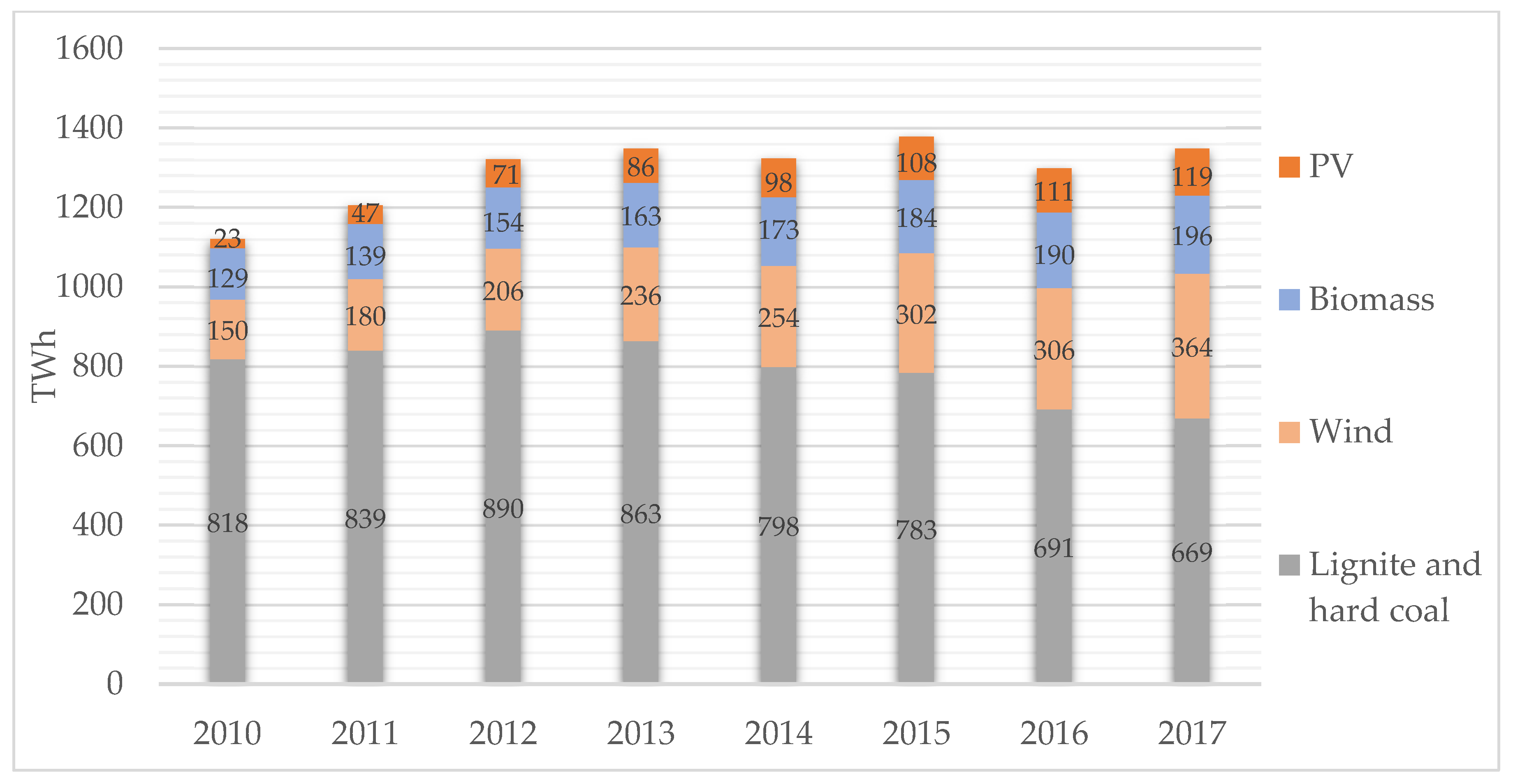
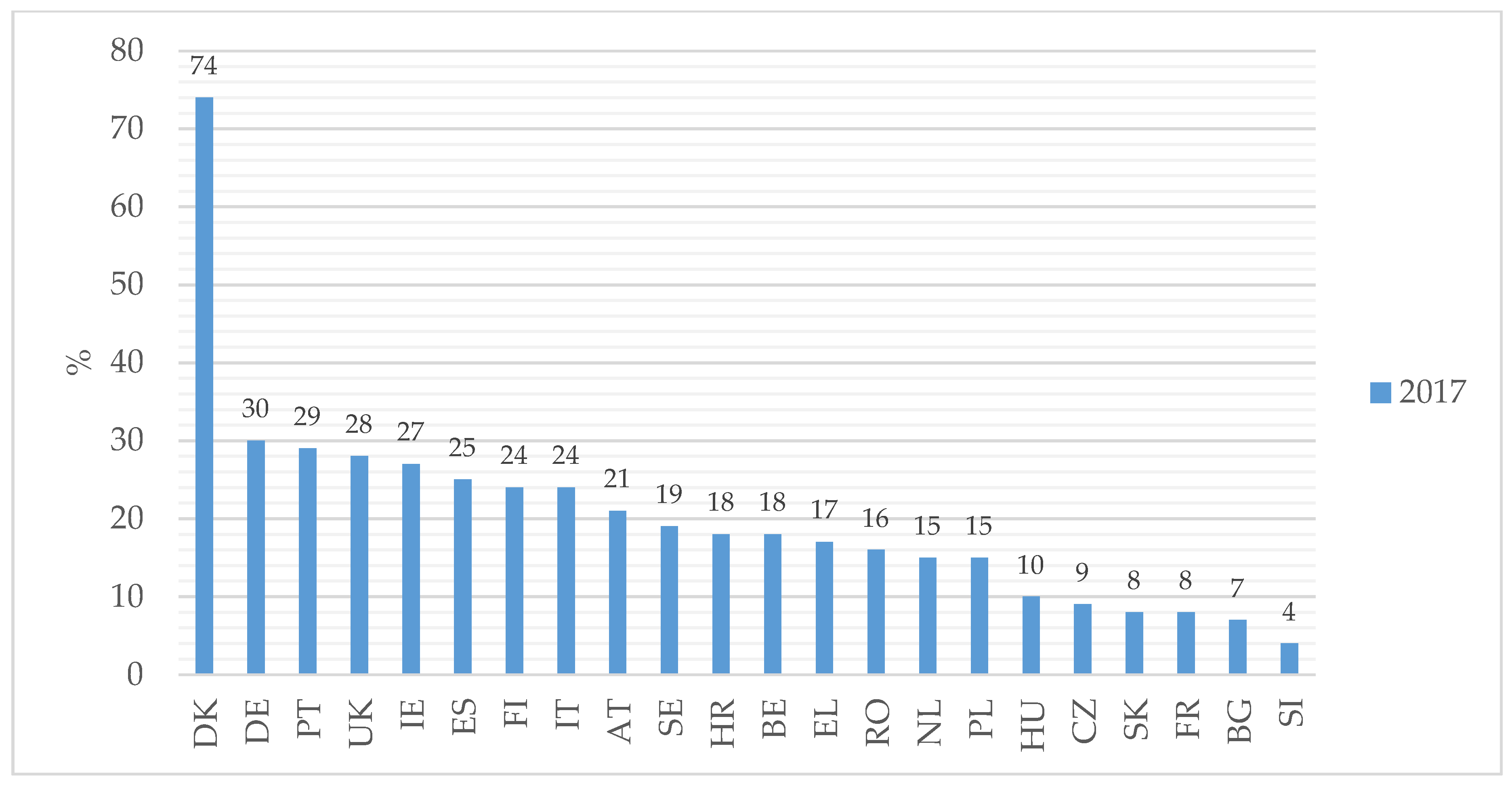
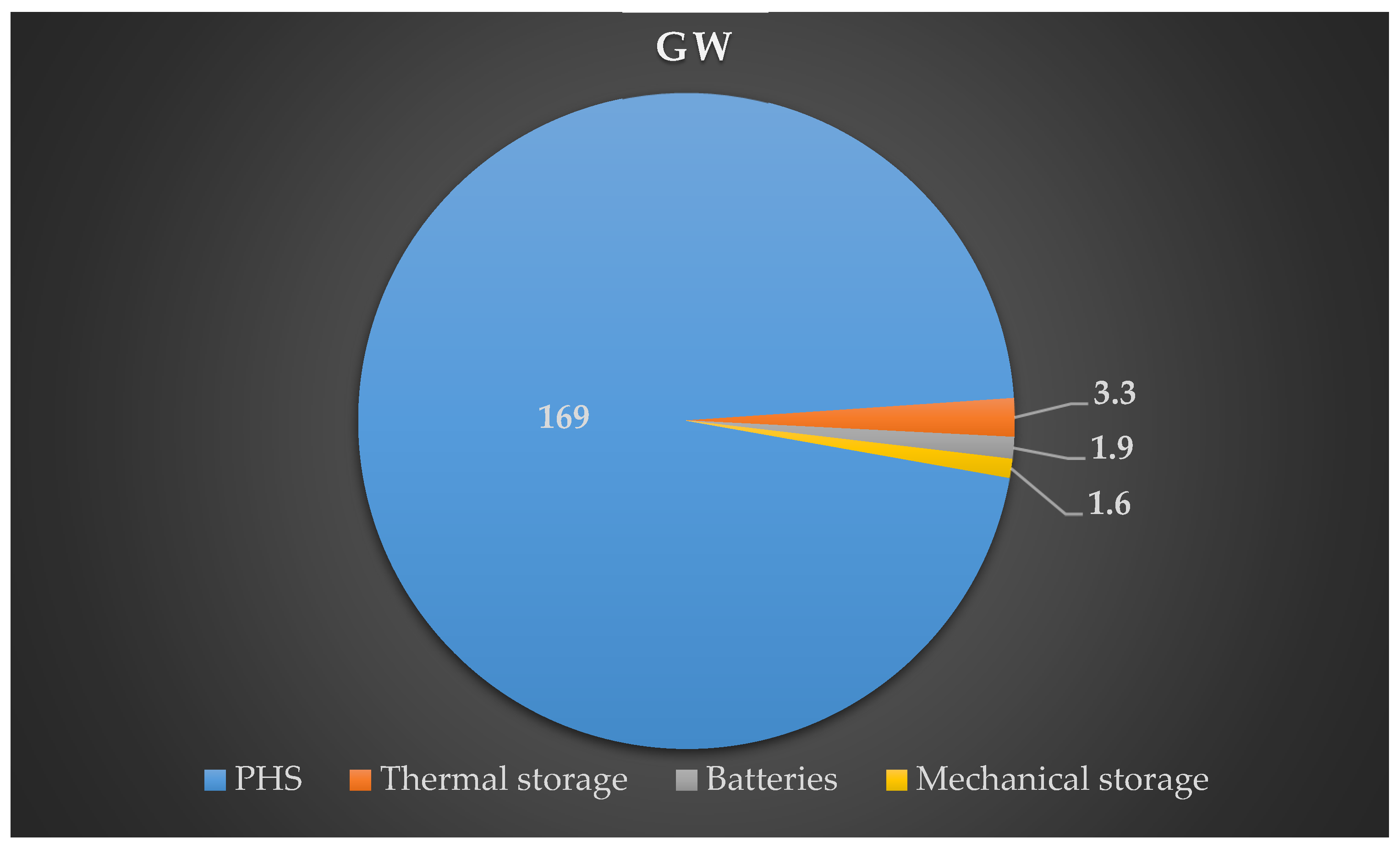
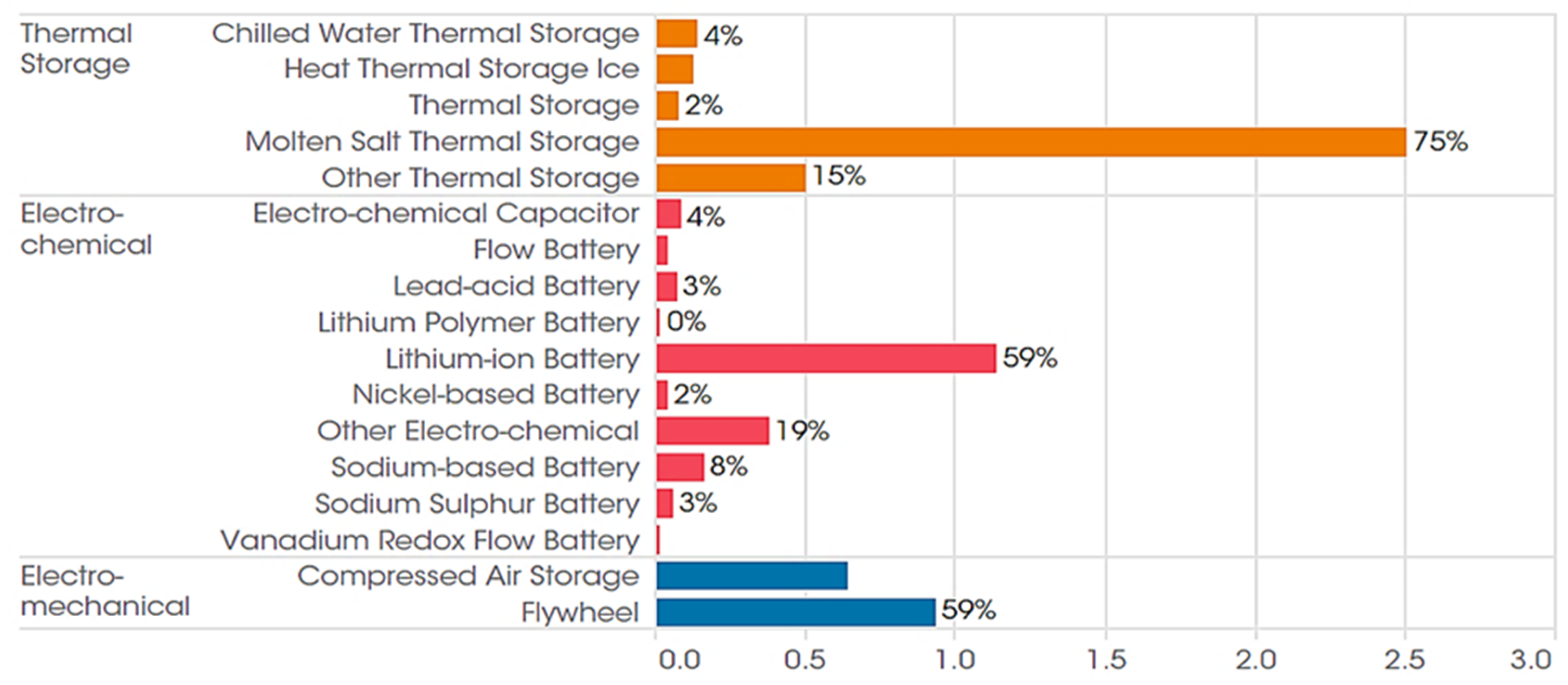
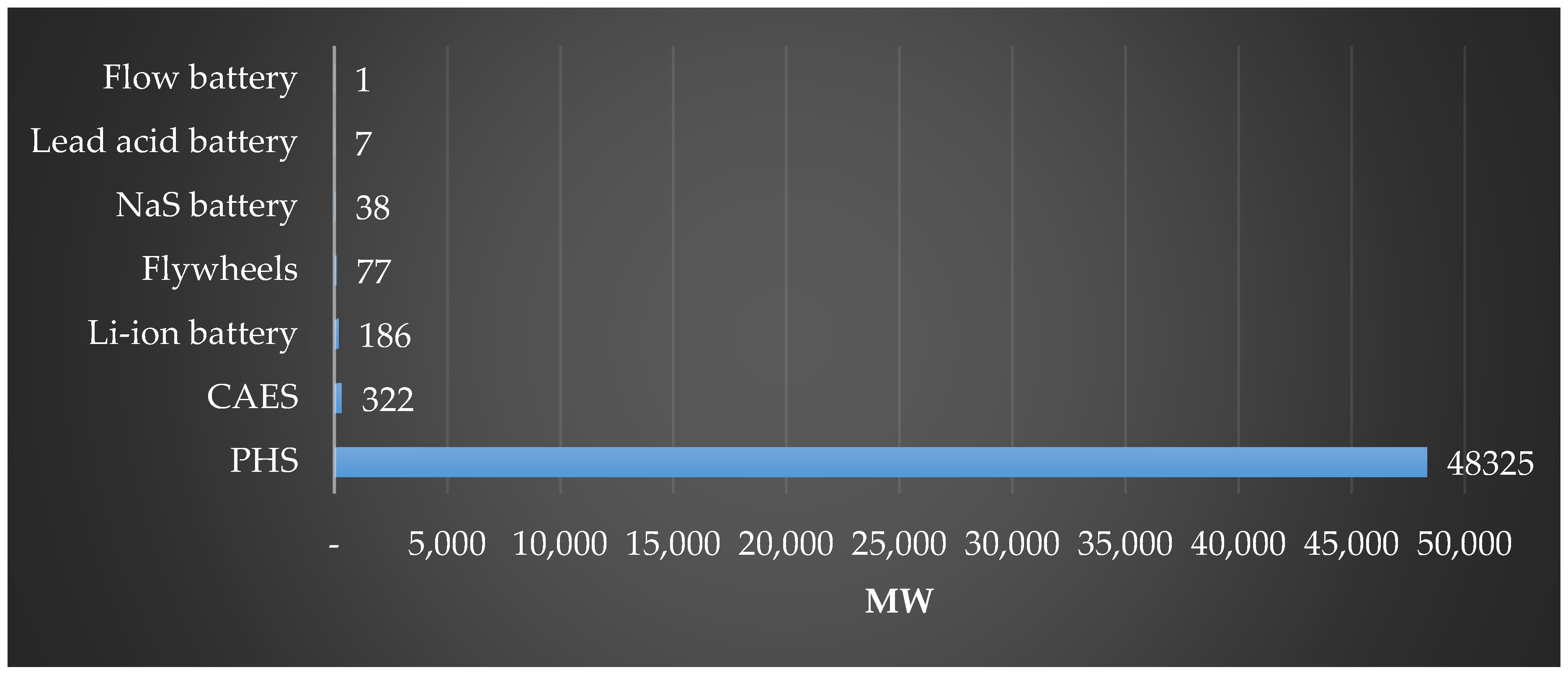
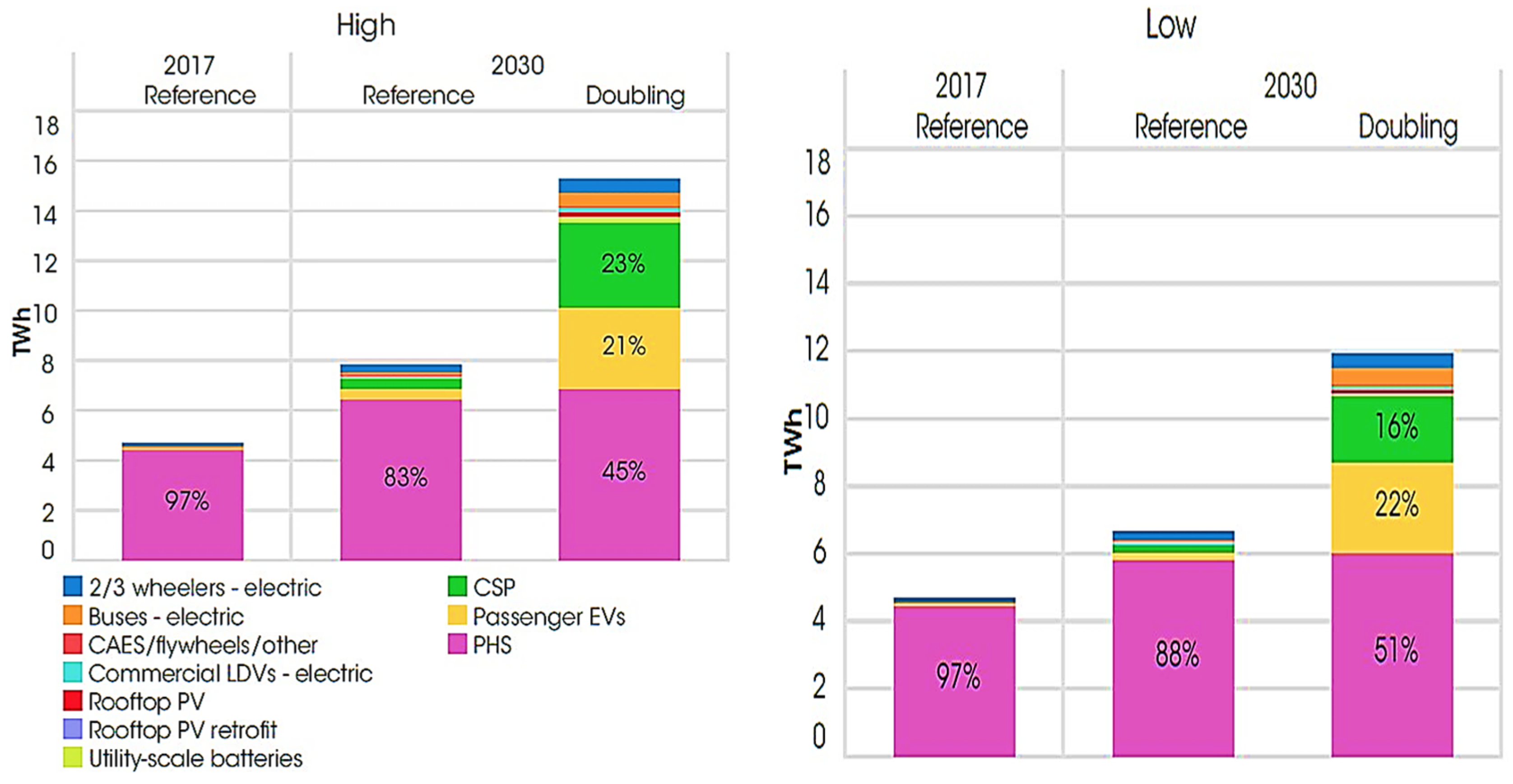
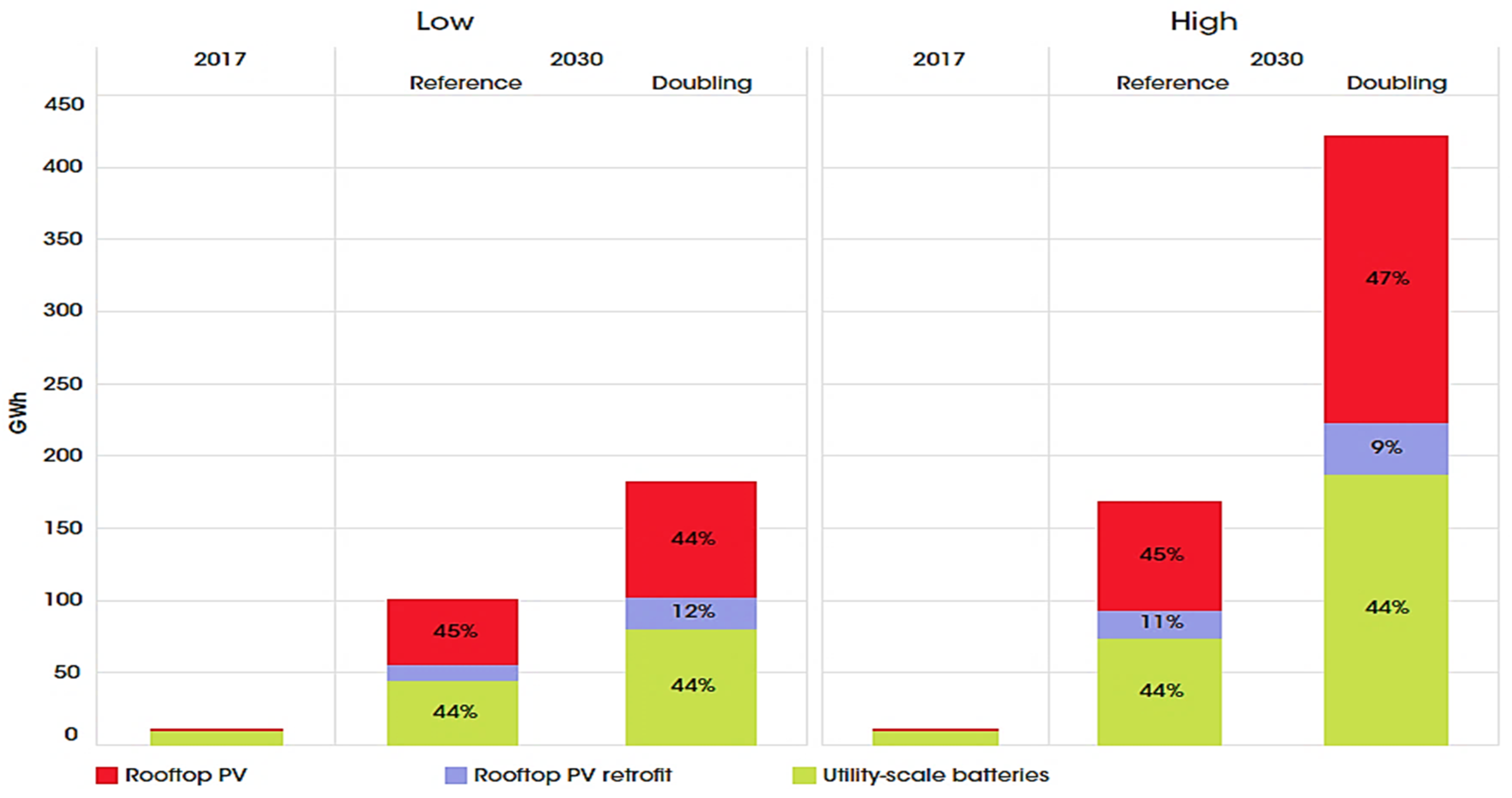
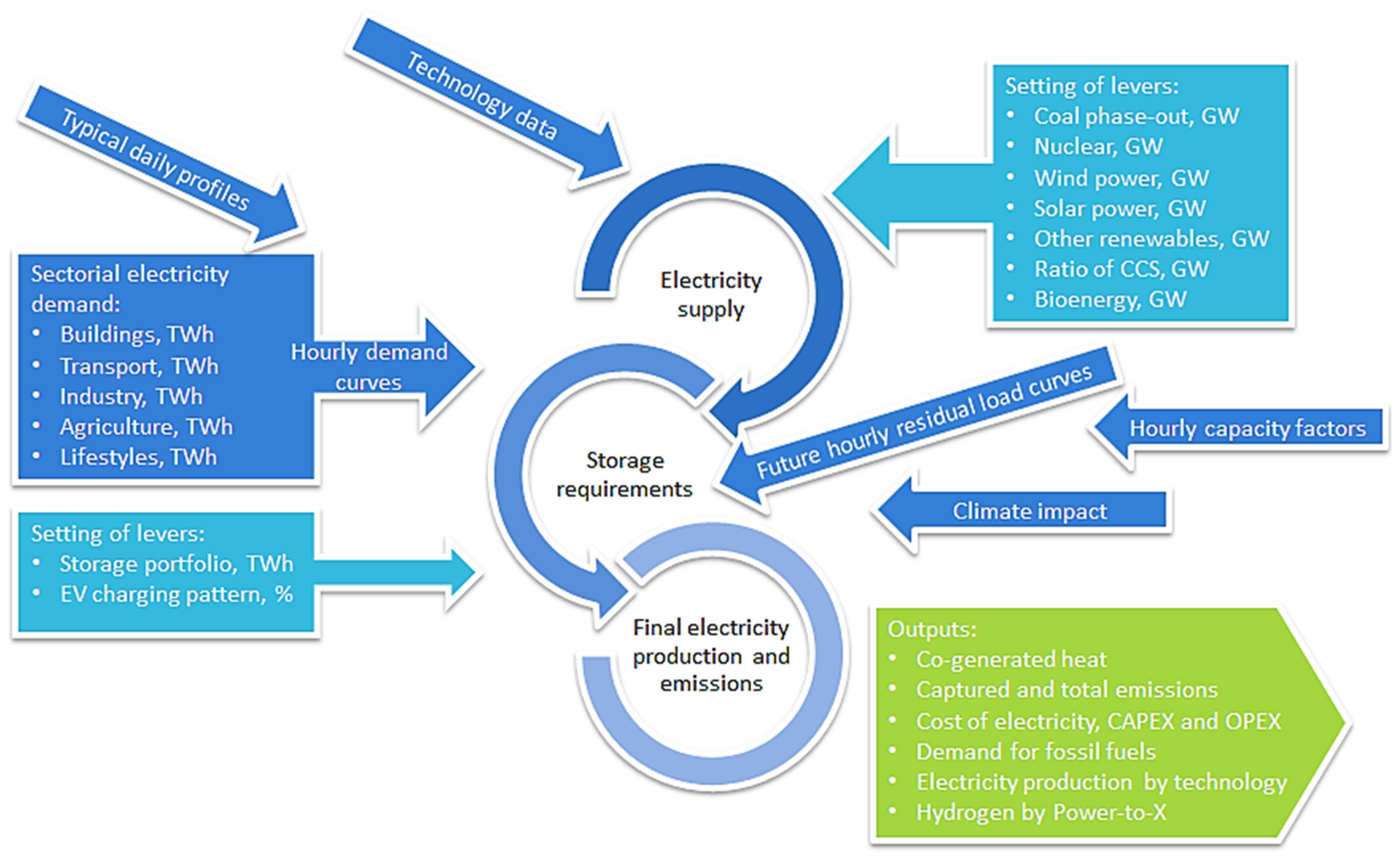
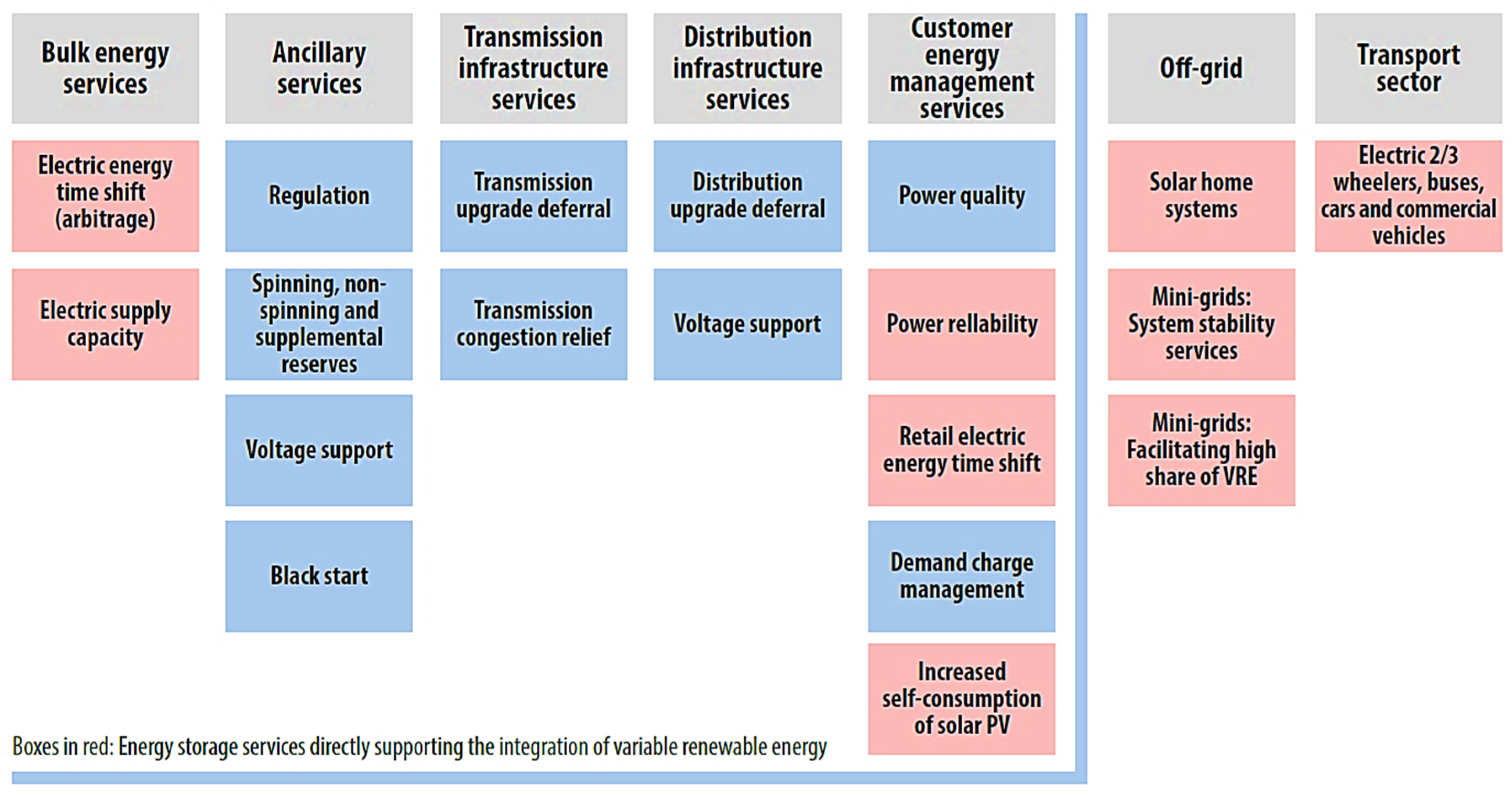
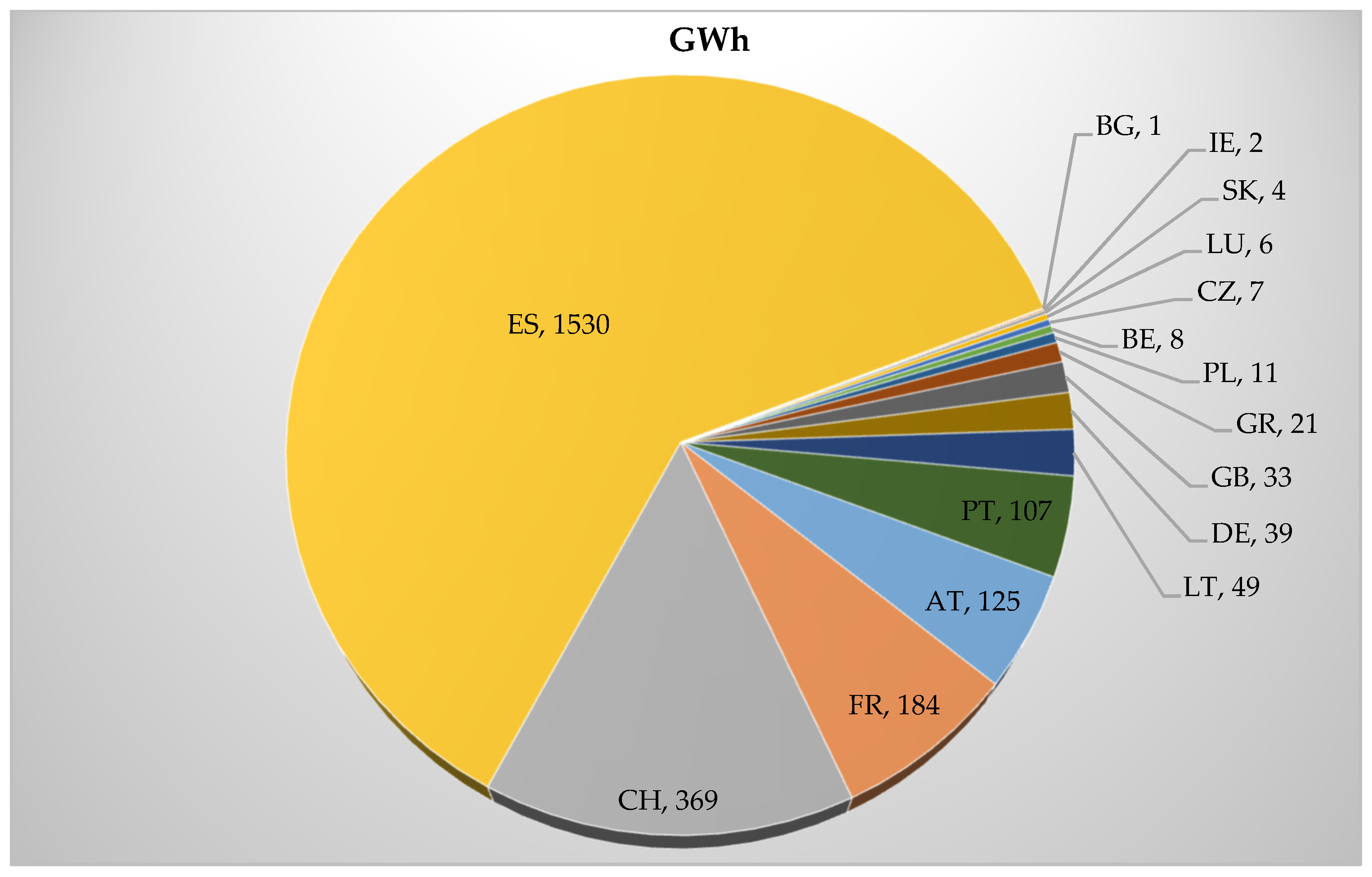
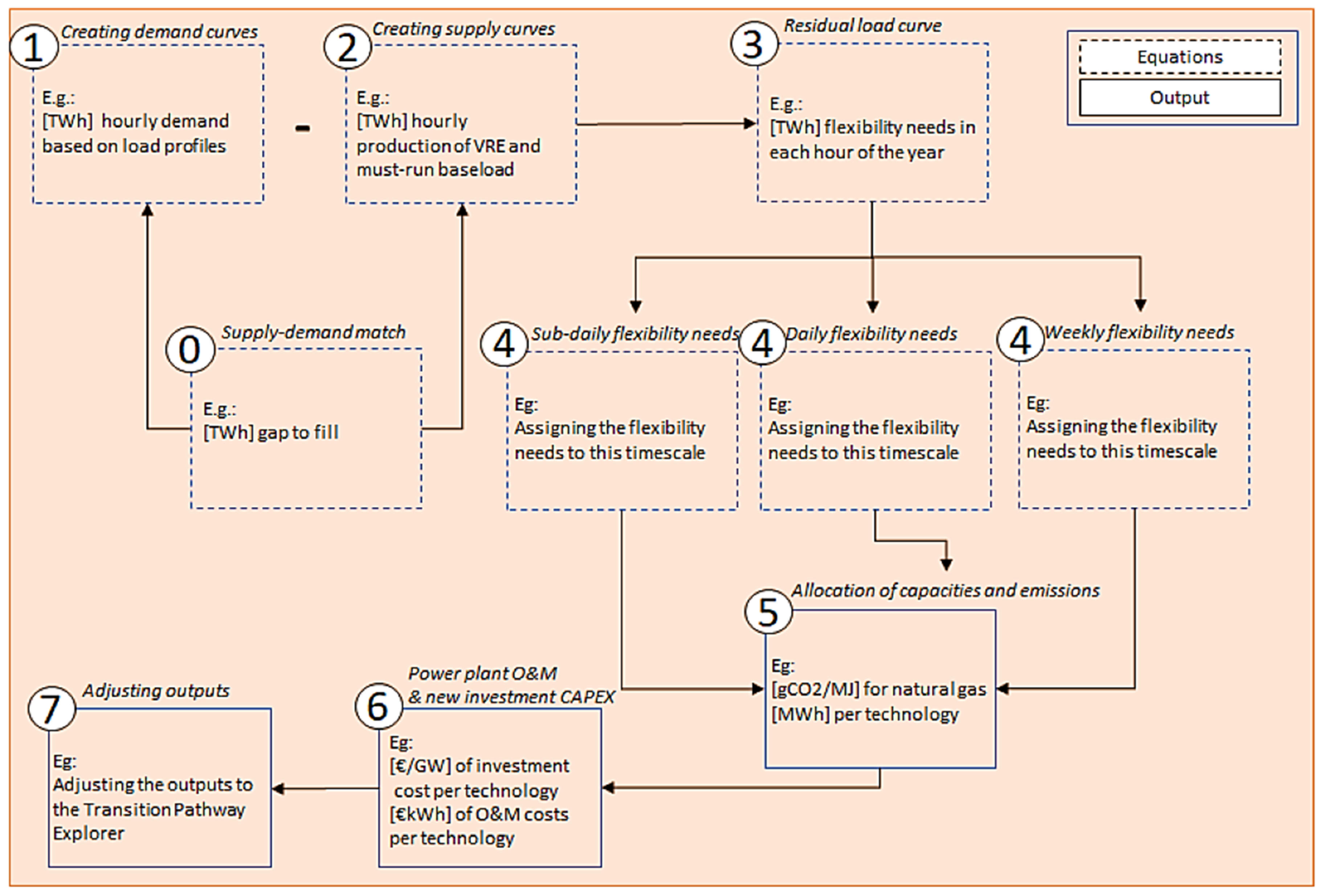
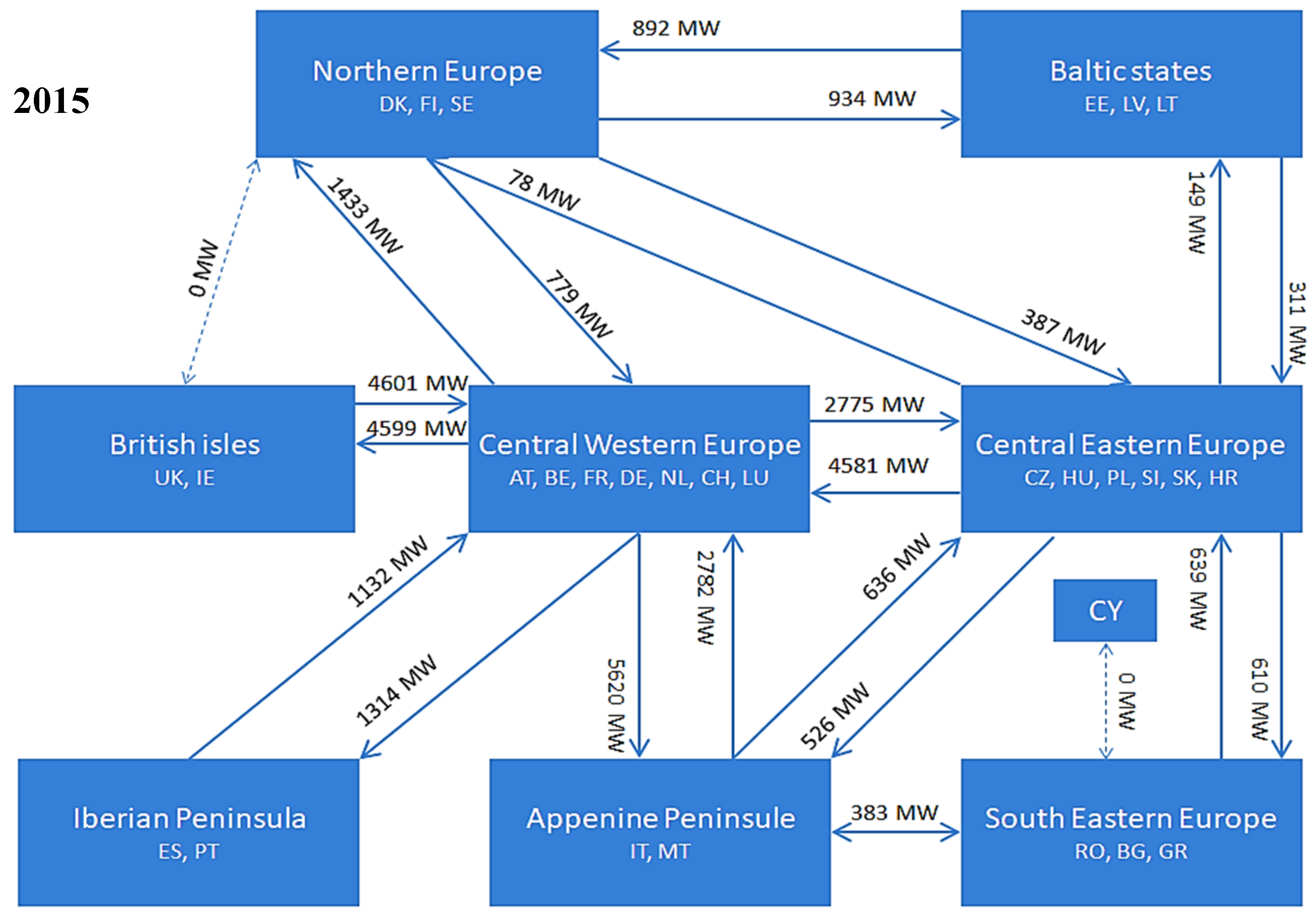
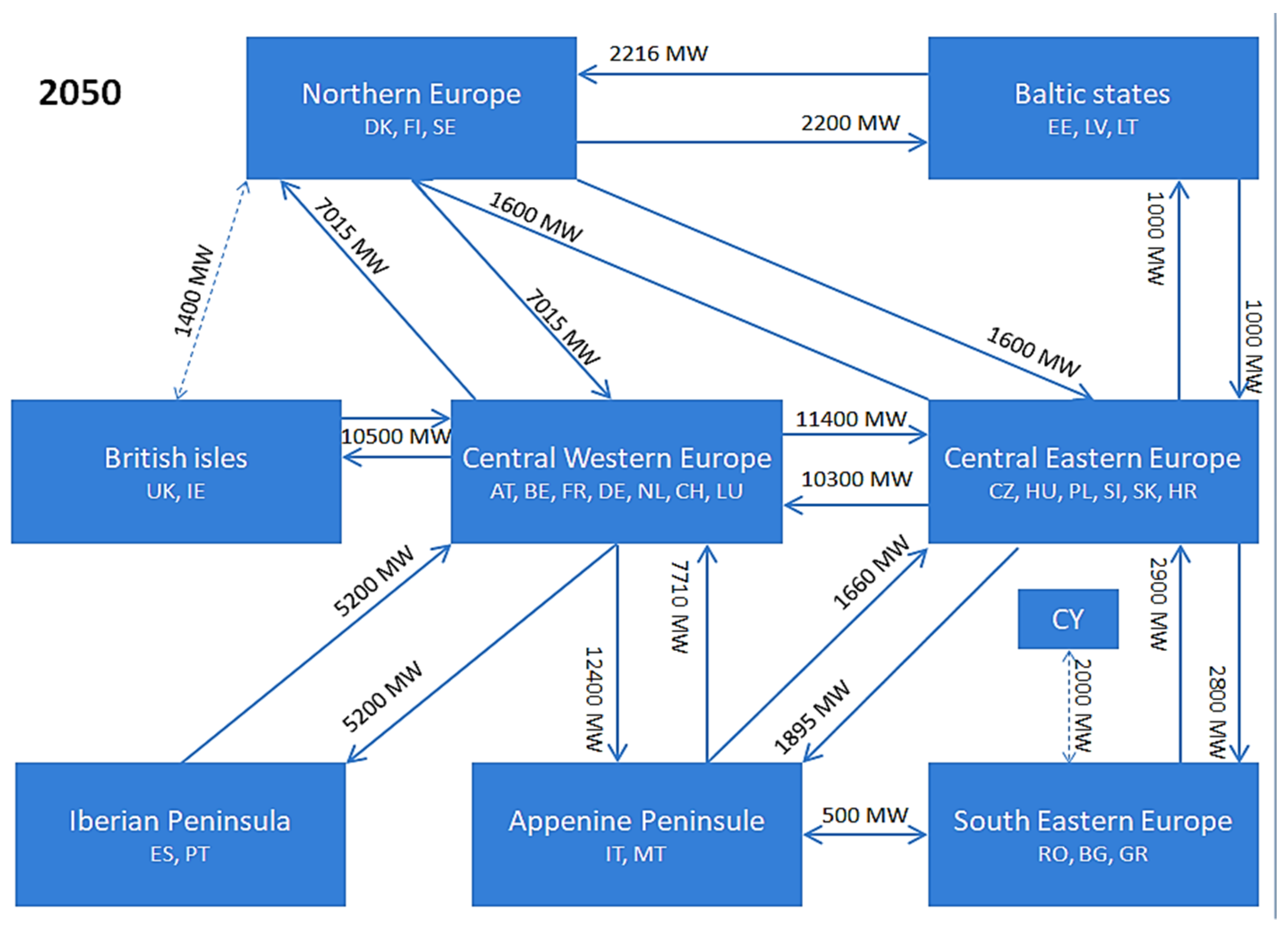
| Balancing Activity | Activation Time | Time Scale in the Storage Sub-Module |
|---|---|---|
| Frequency containment reserve | <30 s | Short-term balancing |
| Frequency restoration reserve with automatic activation | 0.5–2 min | Short-term balancing |
| Frequency restoration reserve with manual activation | 2–15 min | Short-term balancing |
| Replacement reserve | >15 min | Long-term balancing |
| Lever | Brief Description |
|---|---|
| Balancing and storage strategies portfolio | Needed amount of balancing power is shared to the next set of technologies:
|
| Level 1 | Level 2 |
| This scenario considers that electricity storage volumes will grow according to the least ambitious trajectories found in the literature across each technology. | This scenario considers that there will be a rapid breakthrough in battery technologies, therefore this technology is growing according to the most ambitious trajectory. As a result, all other technologies will grow at the least ambitious levels (except PtX that follows an intermediate trajectory). |
| Level 3 | Level 4 |
| This scenario considers that the currently less attractive technologies of compressed air storage (CAES) and flywheels will gain wide-spread acceptance and hence will grow at their most ambitious trajectories. In this case, however, the growth trajectories of PHS and batteries will have an intermediate growth trajectory between their least and most ambitious trajectories. | This scenario considers that all storage technologies grow according to their most ambitious trajectories. This level is considered as transformational and requires some additional breakthrough or efforts such as important cost reduction for some technologies, very fast and extended deployment of infrastructures, major technological advances, strong societal changes, etc. |
| Entso-E Project Number | Country | New Energy Storage Capacity (GWh) | Commissioning Date | Current Status |
|---|---|---|---|---|
| 1000 | Austria | 1.8 | 2022 | Under consideration |
| 1001 | Austria | 152 | 2034 | In permitting |
| 1026 | Austria | 3.5 | 2025 | In permitting |
| 1002 | Belgium | 2 | 2022 | Planned but not yet permitting |
| 1003 | Bulgaria | 5.2 | 2025 | In permitting |
| 1004 | Estonia | 5.45 | 2028 | In permitting |
| 1006 | Greece | 3.974 | 2023 | In permitting |
| 1025 | Ireland | 1.8 | 2026 | Under consideration |
| 1030 | Ireland | 6.1 | 2024 | Planned but not yet permitting |
| 1009 | Lithuania | 8.2 | 2024 | Under consideration |
| 1029 | Slovenia | 8.56 | 2027 | In permitting |
| 1011 | Spain | 75.11 | 2020 | In permitting |
| 1012 | Spain | 3.6 | 2023 | In Permitting |
| 1019 | Spain | 34.9 | 2027 | In permitting |
| 1027 | Spain | 1.62 | 2028 | In permitting |
| 1014 | UK | 30 | 2027 | In Permitting |
| 1015 | UK | 6.9 | 2025 | Under consideration |
| Description | Equation |
|---|---|
| Equation (1), storage fraction (%) | |
| pi parameter values |
| Technology | Round-Trip Efficiency (%) | One Cycle Time (h) | Storage Capacity Per Cycle (GWh) | Maximum Energy Storage Potential during One Year (TWh) | ||||
|---|---|---|---|---|---|---|---|---|
| Least and Most Ambitious | Year 2015 | Year 2050 Least Ambitious | Year 2050 Most Ambitious | Year 2015 | Year 2050 Least Ambitious | Year 2050 Most Ambitious | ||
| Electro-chemical, battery, stationary | 80 | 6 | 0.2 | 81.4 | 361.8 | 0.3 | 119 | 528.2 |
| Electro-mechanical, compressed air | 60 | 12 | 0.7 | 16.3 | 75.0 | 0.5 | 12 | 54.7 |
| Electro-mechanical, flywheel | 85 | 0.5 | 1.2 | 27.8 | 128.6 | 21 | 487 | 2 253 |
| Power-to-gas-to-power | 35 | 48 | 0.1 | 2.3 | 10.7 | 0.02 | 0.4 | 1.9 |
| Region | Countries Included | Estimated Discharge Time for 1 Cycle (Hours) | Existing Rated Power (GW) | ||||
|---|---|---|---|---|---|---|---|
| Year 2015 | Year 2050 Least Ambitious | Year 2050 Most Ambitious | Year 2015 | Year 2050 Least Ambitious | Year 2050 Most Ambitious | ||
| Central Western Europe | FR, NL, BE, LX, DE, AT, CH | 136.7 | 23.4 | 33.0 | 90.1 | ||
| Central Eastern Europe | PL, CZ, HU, SK, SL, CR | 15.0 | 35.0 | 5.1 | 11.6 | 152.9 | |
| South Eastern Europe | RO, BG, GR | 18.9 | 2.1 | 7.4 | 131.1 | ||
| Apennine Peninsula | IT, MT | 13.1 | 7.7 | 7.7 | 71.0 | ||
| Iberian Peninsula | ES, PT | 193.0 | 7.7 | 8.1 | 25.6 | ||
| British Isles | UK, IE | 9.4 | 3 | 7.2 | 95.4 | ||
| Northern Europe | DK, SE, FI | 3.5 | 23.5 | 1.3 | 1.3 | 13.7 | |
| Baltic countries | EE, LV, LT | 50.6 | 0.8 | 1.1 | 1.1 | ||
| Cyprus | CY | 0 | 40* | 0 | 0 | 0.8 | |
| Country | Maximum Energy Storage Potential during One Year (TWh) | ||
|---|---|---|---|
| Year 2015 | Year 2050, Least Ambitious | Year 2050, Most Ambitious | |
| Austria | 22.8 | 50.3 | 77.6 |
| Belgium | 5.7 | 7.1 | 8.5 |
| Bulgaria | 4.4 | 27.2 | 521.2 |
| Croatia | 1.3 | 1.3 | 1.3 |
| Cyprus | - | - | 3.4 |
| Czech Republic | 5.3 | 5.3 | 27.0 |
| Denmark | - | - | - |
| Estonia | - | 0.6 | 0.6 |
| Finland | - | - | 1.3 |
| France | 30.7 | 30.7 | 197.3 |
| Germany | 29.8 | 42.9 | 69.9 |
| Greece | 3.1 | 3.7 | 24.5 |
| Hungary | - | - | 0.4 |
| Ireland | 1.3 | 6.5 | 61.8 |
| Italy | 33.7 | 33.7 | 311.1 |
| Latvia | - | - | - |
| Lithuania | 3.5 | 4.1 | 4.4 |
| Luxembourg | 5.7 | 5.7 | 5.7 |
| Malta | - | - | - |
| Netherlands | - | - | - |
| Poland | 7.9 | 7.9 | 52.3 |
| Portugal | 7.9 | 7.9 | 24.4 |
| Romania | 1.8 | 1.8 | 28.6 |
| Slovakia | 3.9 | 3.9 | 38.4 |
| Slovenia | 0.9 | 6.7 | 30.3 |
| Spain | 25.8 | 27.6 | 87.8 |
| Sweden | 0.4 | 0.4 | 31.9 |
| Switzerland | 7.9 | 7.9 | 35.4 |
| UK | 11.8 | 25.1 | 356.2 |
| EU 28 + CH | sum (TWh) | ||
| 215 | 308 | 2001 | |
| Technology | Ambition Level * | Unit | 2015 | 2020 | 2025 | 2030 | 2035 | 2040 | 2045 | 2050 | |
|---|---|---|---|---|---|---|---|---|---|---|---|
| Level 1 | Electro-chemical, battery, stationary | Least | TWh | 0.3 | 17.2 | 34.2 | 51.1 | 68.0 | 85.0 | 101.9 | 118.8 |
| Pumped hydroelectric storage | Least | TWh | 216 | 217 | 232 | 247 | 262 | 278 | 293 | 308 | |
| Electro-mechanical, compressed air | Least | TWh | 0.5 | 2.1 | 3.8 | 5.4 | 7.0 | 8.7 | 10.3 | 11.9 | |
| Electro-mechanical, flywheel | Least | TWh | 21 | 88 | 154 | 221 | 287 | 354 | 420 | 487 | |
| Power-to-gas-to-power | Least | TWh | 0.02 | 0.07 | 0.1 | 0.2 | 0.3 | 0.3 | 0.4 | 0.4 | |
| Total | TWh | 237 | 324 | 424 | 525 | 625 | 725 | 826 | 926 | ||
| Level 2 | Electro-chemical, battery, stationary | Most | TWh | 0.3 | 17 | 144 | 215 | 286 | 364 | 453 | 528 |
| Pumped hydroelectric storage | Least | TWh | 216 | 217 | 232 | 247 | 262 | 278 | 293 | 308 | |
| Electro-mechanical, compressed air | Least | TWh | 0.51 | 2.1 | 3.8 | 5.4 | 7.0 | 8.7 | 10.3 | 11.9 | |
| Electro-mechanical, flywheel | Least | TWh | 21 | 88 | 154 | 221 | 287 | 354 | 420 | 487 | |
| Power-to-gas-to-power | 2 | TWh | 0.0 | 0.1 | 0.3 | 0.4 | 0.5 | 0.7 | 0.8 | 0.9 | |
| Total | TWh | 237 | 324 | 534 | 689 | 844 | 1005 | 1177 | 1336 | ||
| Level 3 | Electro-chemical, battery, stationary | Intermediate | TWh | 0.3 | 17 | 89 | 133 | 177 | 225 | 277 | 324 |
| Pumped hydroelectric storage | Intermediate | TWh | 216 | 217 | 373 | 529 | 686 | 842 | 998 | 1155 | |
| Electro-mechanical, compressed air | Most | TWh | 0.5 | 2 | 15 | 23 | 30 | 38 | 47 | 55 | |
| Electro-mechanical, flywheel | Most | TWh | 21 | 88 | 626 | 929 | 1229 | 1559 | 1933 | 2253 | |
| Power-to-gas-to-power | 3 | TWh | 0.02 | 0.2 | 0.4 | 0.6 | 0.8 | 1.0 | 1.2 | 1.4 | |
| Total | TWh | 237 | 457 | 1080 | 1703 | 2180 | 2712 | 3254 | 3767 | ||
| Level 4 | Electro-chemical, battery, stationary | Most | TWh | 0 | 17 | 144 | 215 | 286 | 364 | 453 | 528 |
| Pumped hydroelectric storage | Most | TWh | 216 | 217 | 514 | 812 | 1109 | 1407 | 1704 | 2002 | |
| Electro-mechanical, compressed air | Most | TWh | 0.5 | 2.1 | 15.2 | 22.6 | 29.9 | 37.9 | 47.0 | 54.7 | |
| Electro-mechanical, flywheel | Most | TWh | 21 | 88 | 626 | 929 | 1229 | 1559 | 1933 | 2253 | |
| Power-to-gas-to-power | Most | TWh | 0.0 | 0.1 | 0.5 | 0.8 | 1.1 | 1.3 | 1.7 | 1.9 | |
| Total | TWh | 237 | 324 | 1299 | 1979 | 2656 | 3369 | 4139 | 4839 | ||
| Year | 2040 | |||
|---|---|---|---|---|
| Estimated EU + CH Electricity Demand (TWh) | 3537 | |||
| Levels | 1 | 2 | 3 | 4 |
| Aggregate energy storage capacity of all storage technologies (GWh) | 3306 | 3498 | 7170 | 12,375 |
| Theoretical maximum of the annual VRE gross electricity generation compared to the demand (%) | 54.8 | 55.2 | 60.9 | 65.8 |
| Required storage fraction (%) | 0.093 | 0.099 | 0.203 | 0.350 |
© 2020 by the authors. Licensee MDPI, Basel, Switzerland. This article is an open access article distributed under the terms and conditions of the Creative Commons Attribution (CC BY) license (http://creativecommons.org/licenses/by/4.0/).
Share and Cite
Gyalai-Korpos, M.; Zentkó, L.; Hegyfalvi, C.; Detzky, G.; Tildy, P.; Hegedűsné Baranyai, N.; Pintér, G.; Zsiborács, H. The Role of Electricity Balancing and Storage: Developing Input Parameters for the European Calculator for Concept Modeling. Sustainability 2020, 12, 811. https://doi.org/10.3390/su12030811
Gyalai-Korpos M, Zentkó L, Hegyfalvi C, Detzky G, Tildy P, Hegedűsné Baranyai N, Pintér G, Zsiborács H. The Role of Electricity Balancing and Storage: Developing Input Parameters for the European Calculator for Concept Modeling. Sustainability. 2020; 12(3):811. https://doi.org/10.3390/su12030811
Chicago/Turabian StyleGyalai-Korpos, Miklós, László Zentkó, Csaba Hegyfalvi, Gergely Detzky, Péter Tildy, Nóra Hegedűsné Baranyai, Gábor Pintér, and Henrik Zsiborács. 2020. "The Role of Electricity Balancing and Storage: Developing Input Parameters for the European Calculator for Concept Modeling" Sustainability 12, no. 3: 811. https://doi.org/10.3390/su12030811
APA StyleGyalai-Korpos, M., Zentkó, L., Hegyfalvi, C., Detzky, G., Tildy, P., Hegedűsné Baranyai, N., Pintér, G., & Zsiborács, H. (2020). The Role of Electricity Balancing and Storage: Developing Input Parameters for the European Calculator for Concept Modeling. Sustainability, 12(3), 811. https://doi.org/10.3390/su12030811






